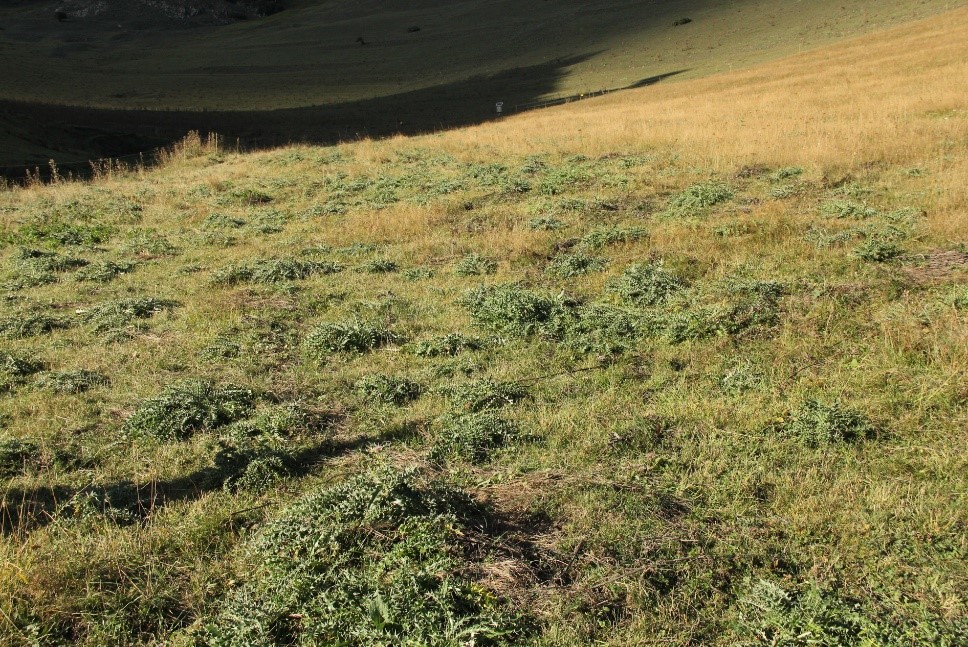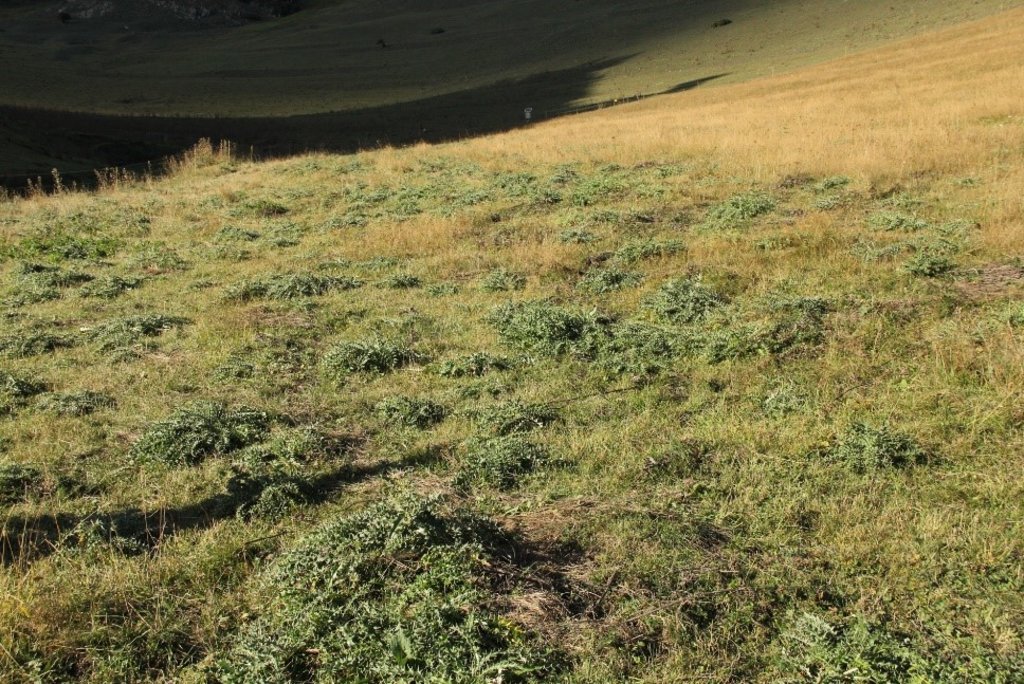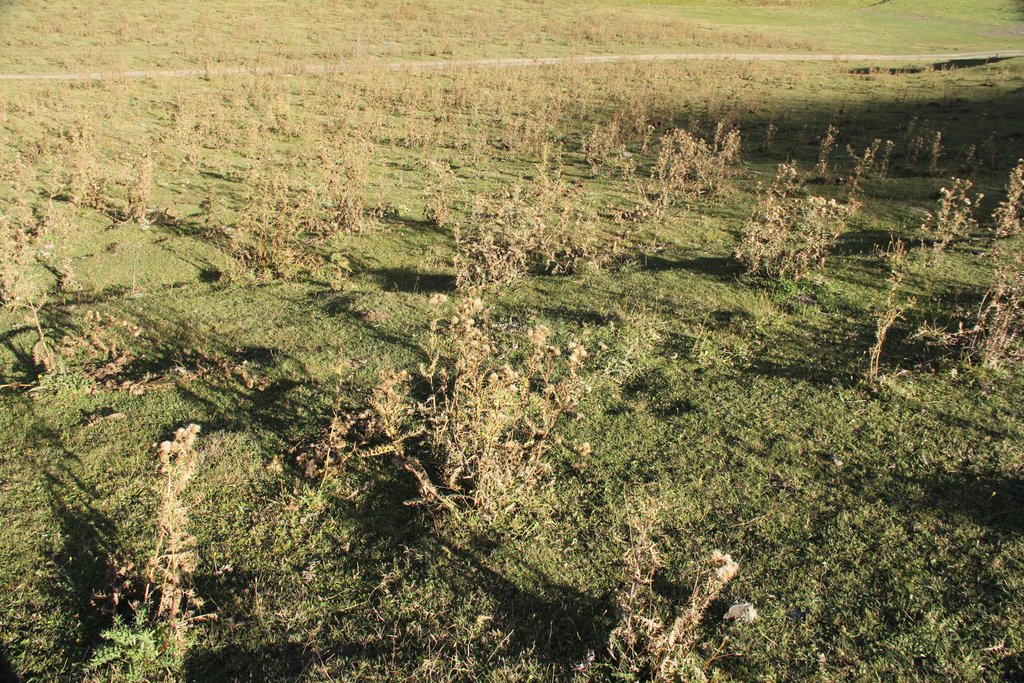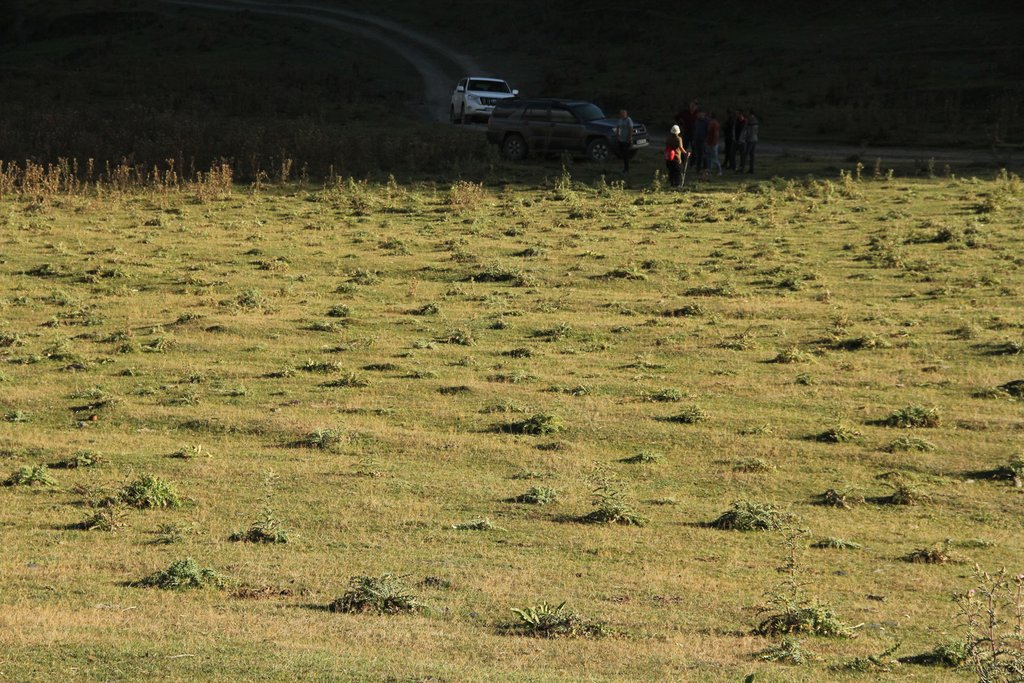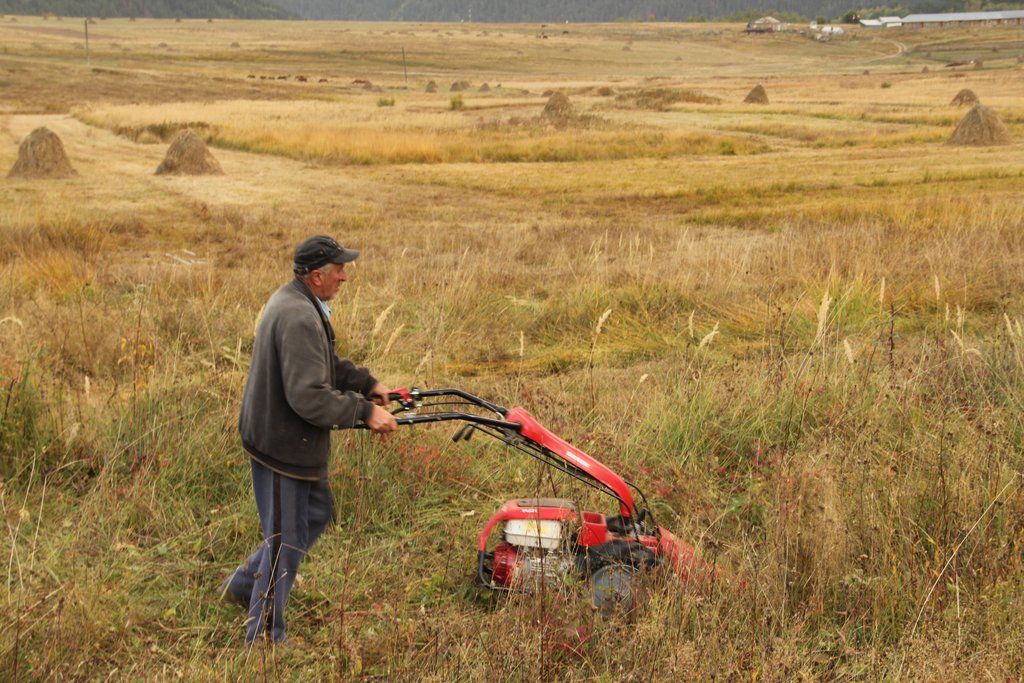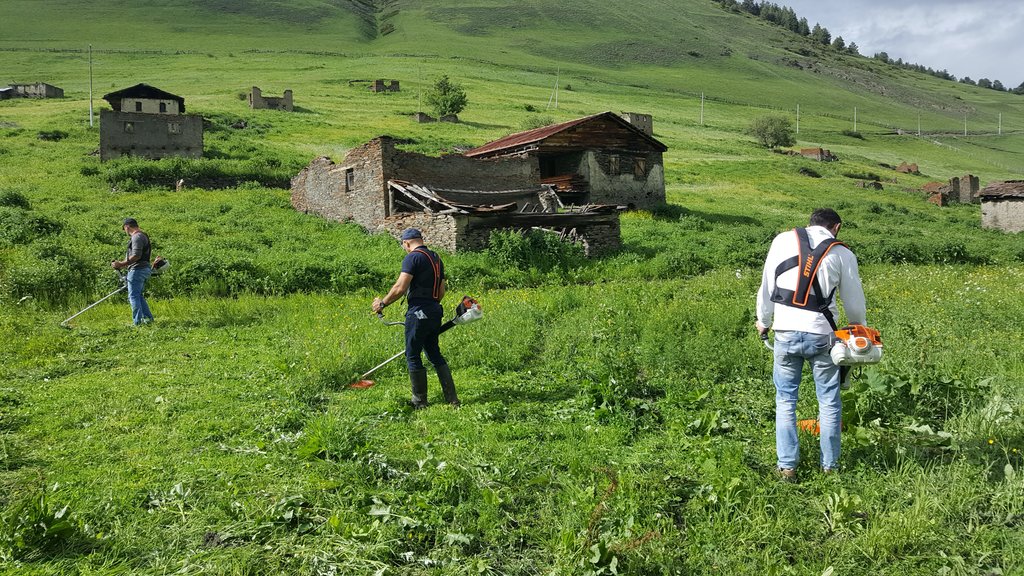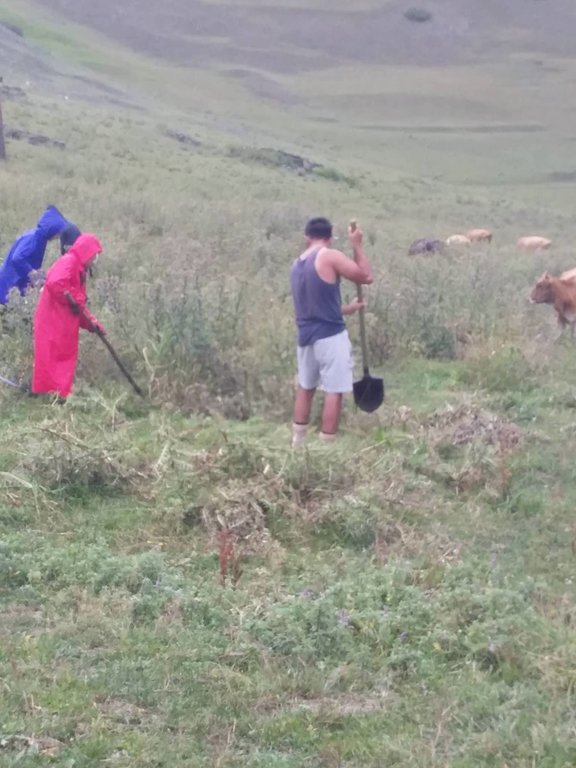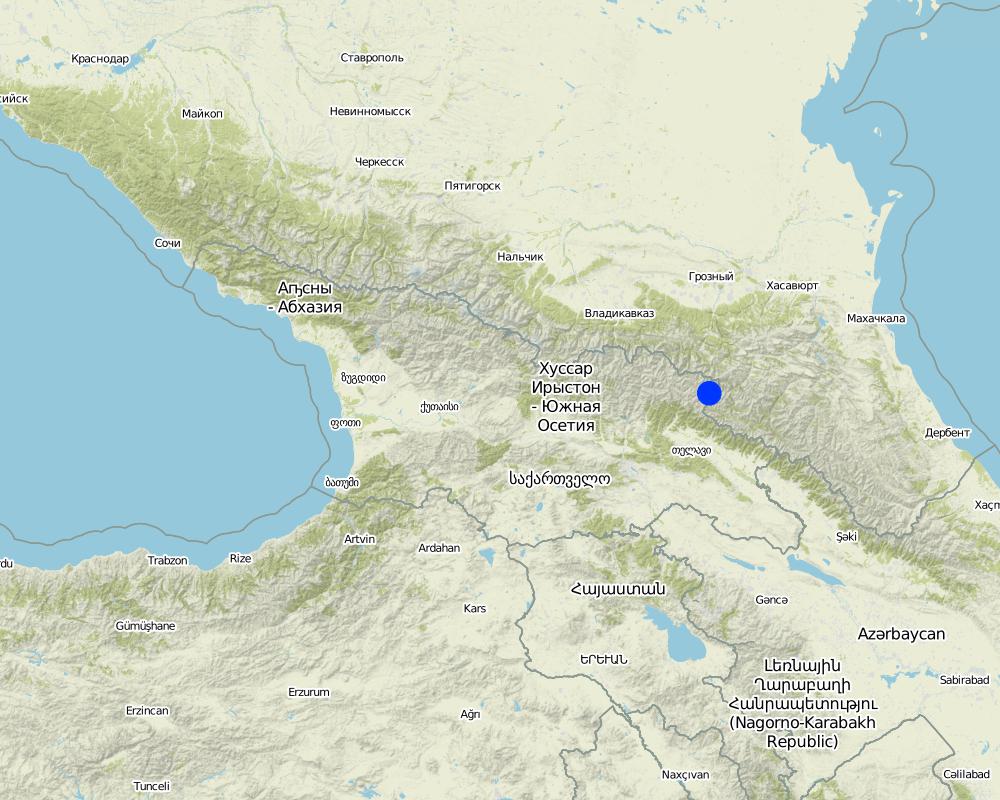Pasture-weed control by thistle cutting [Georgia]
- Creación:
- Actualización:
- Compilador: Hanns Kirchmeir
- Editor: Kety Tsereteli
- Revisor: Ursula Gaemperli
technologies_4273 - Georgia
Visualizar secciones
Expandir todo Colapsar todos1. Información general
1.2 Detalles de contacto de las personas de referencia e instituciones involucradas en la evaluación y la documentación de la Tecnología
co-compiler:
Nombre del proyecto que financió la documentación/ evaluación de la Tecnología (si fuera relevante)
Applying Landscape and Sustainable Land Management (L-SLM) for mitigating land degradation and contributing to poverty reduction in rural area (L-SLM Project)Nombre de la(s) institución(es) que facilitaron la documentación/ evaluación de la Tecnología (si fuera relevante)
Regional Environmental Centre for the Caucasus (REC Caucasus) - Georgia1.3 Condiciones referidas al uso de datos documentados mediante WOCAT
El compilador y la/s persona(s) de referencia claves aceptan las condiciones acerca del uso de los datos documentados mediante WOCAT:
Sí
1.4 Declaración de la sostenibilidad de la Tecnología descrita
¿La Tecnología aquí descrita resulta problemática en relación a la degradación de la tierra, de tal forma que no puede considerársela una tecnología sostenible para el manejo de la tierra?
No
Comentarios:
The applied technology avoids the application of chemicals by mechanical weed removal.
1.5 Referencia al (los) Cuestionario(s) de Enfoques MST (documentados usando WOCAT)
2. Descripción de la Tecnología MST
2.1 Breve descripción de la Tecnología
Definición de la Tecnología:
Thistles invaded massively into village pasture land at 1800m elevation in the Caucasus. By cutting the thistles with a motor-cutter the cover of thistles have been reduced.
2.2 Descripción detallada de la Tecnología
Descripción:
The technology was applied in flat sub-alpine pasture land at an elevation of about 1800 m in the village of Shenako in the Tusheti Protected Landscape, Georgia. Precipitation is 750-900mm and mean annual temperature is 2-4°C. Thistles (Cirsium sp.) were invading especially in those sections of the pasture that are rich in nutrients and have medium soil water content. This site conditions can be found mainly at the valley bottom.
There are no big machines available in this mountain villages. So the removal was done by motor-cutters. In this particular case STIHL petrol brush cutters were used with a 3 blade bush knife.
The removal of the thistles, which were covering up to 20% of the pasture land will increase the productivity of valuable fodder grass and herbs. The thistles are growing up to 1m height and taking up significant amount of nutrients from the soil and are shading other grass and herbs in their neighborhood. Because of their spices they are not eaten by cows or sheep, while the grazing pressure is increasing on the remaining grass and herb species. This leads to positive selection of thistles and a permanent increase of the thistles number and biomass in comparison to the high quality fodder plants.
The thistles have been cut in mid-June/beginning of July just at the begin of blossom. At this stage, the thistles mobilized most of the nutrients from their root system and spent them in leaf and blossom biomass. By cutting the thistles at this time, the highest impact on the nutrient balance can be reached and no new seeds will be produced in this year. It was observed, that the thistles have been eaten by the livestock when it was cut and dried up.
The motor brush cutter increases significantly the speed of cutting the thistles compared to hand scythe. The thistle has a powerful root system and is re-sprouting from the roots within the same summer. So it is important to repeat the cutting 2-3 times a year and to continue several years until the amount of thistles is permanently reduced.
The reduction of thistles will give more space, nutrients and moisture to other fodder plants and increase the productivity of the pasture land.
The challenge is the coordination of the work load within the users of the community pasture land. It needs a (written) agreement to share the workload for pasture maintenance between the families according to their number of livestock.
2.3 Fotografías de la Tecnología
Comentarios generales sobre las fotos:
The photos are showing the state of the pastures before and 2 months after the application of the technology.
2.4 Videos de la Tecnología
Comentarios, descripción breve:
No video available
2.5 País/ región/ lugares donde la Tecnología fue aplicada y que se hallan comprendidos por esta evaluación
País:
Georgia
Región/ Estado/ Provincia:
Kakheti
Especifique más el lugar :
Shenako
Especifique la difusión de la Tecnología:
- distribuida parejamente sobre un área
Si la Tecnología se halla difundida homogéneamente a lo largo de un área, especifique el área que cubre (en km2):
0,02
Si se desconoce el área precisa, indique el área aproximada cubierta:
- < 0.1 km2 (10 ha)
¿El/los sitio(s) de la Tecnología se ubica(n) en un área de protección permanente?
Sí
Si fuera el caso, especifique :
The village of Shenako is located in the Tusheti Protected Landscape. This category is managed by the Municipality of Akhmeta.
Comentarios:
The number of families using the village pastureland for their livestock has decreased during the last decades. In former times the 200 ha of open land around the village was used as arable land and hay meadows and the livestock was grazed on remote pastures.
Map
×2.6 Fecha de la implementación
Indique año de implementación:
2018
2.7 Introducción de la Tecnología
Especifique cómo se introdujo la Tecnología:
- mediante proyectos/ intervenciones externas
Comentarios (tipo de proyecto, etc.):
The weed control was funded and applied within a GEF Projected coordinated by REC Caucasus ("Applying Landscape and Sustainable Land Management (L-SLM) for mitigating land degradation and contributing to poverty reduction in rural areas"). It can be assumed, that there have been community based regulation on pasture maintenance before the Soviet period, but this regulations have not been re-established after this period.
3. Clasificación de la Tecnología MST
3.1 Propósito(s) principal(es) de la Tecnología MST
- mejorar la producción
- reducir, prevenir, restaurar la degradación del suelo
- crear impacto económico benéfico
3.2 Tipo(s) actuales de uso de la tierra donde se aplica la Tecnología
Mezcla de tipos de uso de tierras dentro de la misma unidad de tierras: :
No

Tierra de pastoreo
Pastoreo extenso:
- Pastoralismo trashumante
Tipo de animal:
- ganado - lechero
- caballos
- ovejas
¿Se practica el manejo integrado de cultivos - ganado?
No
Productos y servicios:
- carne
- leche
Especies:
ganado - lechero
Conteo:
70
Especies:
ovejas
Conteo:
400
Especies:
caballos
Conteo:
30
Especies:
ganado - carne de res no lechera
Conteo:
35
Comentarios:
The area of implementation is community pasture land.
3.3 ¿Cambió el uso de tierras debido a la implementación de la Tecnología?
¿Cambió el uso de tierras debido a la implementación de la Tecnología?
- No (Continúe con la pregunta 3.4)
3.4 Provisión de agua
Provisión de agua para la tierra donde se aplica la Tecnología:
- de secano
3.5 Grupo MST al que pertenece la Tecnología
- pastoralismo y manejo de tierras de pastoreo
3.6 Medidas MST que componen la Tecnología

medidas de manejo
- M5: Control/ cambio de composición de las especies
Comentarios:
The technology aims to reduce the amount of thistles in the species composition of the pasture.
3.7 Principales tipos de degradación del suelo encarados con la Tecnología

degradación biológica
- Bs: reducción en la calidad y composición/ diversidad de las especies
Comentarios:
The degradation of the pastures is driven by the spreading of thistles. This process leads to a reduction of plant-diversity (shading) and fodder production.
3.8 Prevención, reducción o restauración de la degradación del suelo
Especifique la meta de la Tecnología con relación a la degradación de la tierra:
- reducir la degradación del suelo
Comentarios:
Cutting thistles is an measure for weed-control and reduces the risk of overgrazing be increasing the available area and amount of fodder plants.
4. Especificaciones técnicas, actividades de implementación, insumos y costos
4.1 Dibujo técnico de la Tecnología
Especificaciones técnicas (relacionadas al dibujo técnico):
The activity was applied on two plots. Plot 6 is 0.7 ha of size and located in the unfenced area. Plot 7 is 1.3 ha of size and located inside an electric fence. The hatched area (8) is indicating the fenced area.
Autor:
Hanns Kirchmeir
Fecha:
20/03/2019
4.2 Información general sobre el cálculo de insumos y costos
Especifique cómo se calcularon los costos e insumos:
- por área de Tecnología
Indique tamaño y unidad de área:
2 ha
Especifique la moneda usada para calcular costos:
- USD
4.3 Actividades de establecimiento
| Actividad | Momento (estación) | |
|---|---|---|
| 1. | Prepare machinery and organize people | June |
| 2. | Select pasture plots were the measure will be applied | June |
| 3. | Cut the thistles on the selected pasture plots | End of June - Mid of July |
Comentarios:
When working with a hand-held brush cutter it is recommended to start in those areas with less thistles and work into the direction of dense thistle stands. When working with a tractor or a sickle bar mower it is more efficient to apply the activity in dens thistle stands.
4.4 Costos e insumos necesarios para el establecimiento
| Especifique insumo | Unidad | Cantidad | Costos por unidad | Costos totales por insumo | % de los costos cubiertos por los usuarios de las tierras | |
|---|---|---|---|---|---|---|
| Mano de obra | Selection of sites, preparation of materials and people | person-days | 3,0 | 37,0 | 111,0 | |
| Mano de obra | Labour for cutting thistles on 2 ha | person-days | 10,0 | 20,0 | 200,0 | |
| Equipo | High quality brush cutter | pieces | 1,0 | 800,0 | 800,0 | |
| Equipo | Patrol (20l) and diesel (30l) for brush cutter (6 days, 8h/day, 1l/h) | liter | 50,0 | 1,0 | 50,0 | |
| Costos totales para establecer la Tecnología | 1161,0 | |||||
| Costos totales para establecer la Tecnología en USD | 1161,0 | |||||
Si el usuario de la tierra no cubrió el 100% de los costos, indique quién financió el resto del costo:
The equipment (brush cutters) and labour costs have been carried by international project (GIZ-IBiS Program, GEF funded SML Project)
4.5 Actividades de establecimiento/ recurrentes
| Actividad | Momento/ frequencia | |
|---|---|---|
| 1. | Repeat cutting of thistles 2x per year | June/July and September |
4.6 Costos e insumos necesarios para actividades de mantenimiento/ recurrentes (por año)
| Especifique insumo | Unidad | Cantidad | Costos por unidad | Costos totales por insumo | % de los costos cubiertos por los usuarios de las tierras | |
|---|---|---|---|---|---|---|
| Mano de obra | labour for cutting thistles (2ha) | person-days | 6,0 | 20,0 | 120,0 | 100,0 |
| Equipo | Patrol for brush cutter | liter | 96,0 | 1,0 | 96,0 | |
| Indique los costos totales para mantenecer la Tecnología | 216,0 | |||||
| Costos totales para mantener la Tecnología en USD | 216,0 | |||||
Comentarios:
The ongoing maintenance has to be covered by the local farmers
4.7 Factores más determinantes que afectan los costos:
Describa los factores más determinantes que afectan los costos:
The investment in the brush cutter will only pay off if large parts of pastures are managed.
5. Entorno natural y humano
5.1 Clima
Lluvia anual
- < 250 mm
- 251-500 mm
- 501-750 mm
- 751-1,000 mm
- 1,001-1,500 mm
- 1,501-2,000 mm
- 2,001-3,000 mm
- 3,001-4,000 mm
- > 4,000 mm
Especifique el promedio anual de lluvia (si lo conoce), en mm:
850,00
Especificaciones/ comentarios sobre la cantidad de lluvia:
Main rainfall in spring and autumn, July and August is the dry season.
Indique el nombre de la estación metereológica de referencia considerada:
Data from CHELSA.ORG
Zona agroclimática
- Sub-húmeda
Because of low annual temperature (2-4°C) the evapotranspiration is low and most of the year there is no water shortage. But in August and September drought can occur.
5.2 Topografía
Pendientes en promedio:
- plana (0-2 %)
- ligera (3-5%)
- moderada (6-10%)
- ondulada (11-15%)
- accidentada (16-30%)
- empinada (31-60%)
- muy empinada (>60%)
Formaciones telúricas:
- meseta/ planicies
- cordilleras
- laderas montañosas
- laderas de cerro
- pies de monte
- fondo del valle
Zona altitudinal:
- 0-100 m s.n.m.
- 101-500 m s.n.m.
- 501-1,000 m s.n.m
- 1,001-1,500 m s.n.m
- 1,501-2,000 m s.n.m
- 2,001-2,500 m s.n.m
- 2,501-3,000 m s.n.m
- 3,001-4,000 m s.n.m
- > 4,000 m s.n.m
Indique si la Tecnología se aplica específicamente en:
- situaciones cóncavas
Comentarios y especificaciones adicionales sobre topografía :
The most dense thistle populations are observed on the flat valley floors and concave depressions at the slopes where the soil is rich in nutrients and has well balanced soil moisture.
5.3 Suelos
Profundidad promedio del suelo:
- muy superficial (0-20 cm)
- superficial (21-50 cm)
- moderadamente profunda (51-80 cm)
- profunda (81-120 cm)
- muy profunda (>120 cm)
Textura del suelo (capa arable):
- mediana (limosa)
- fina/ pesada (arcilla)
Textura del suelo (> 20 cm debajo de la superficie):
- mediana (limosa)
- fina/ pesada (arcilla)
Materia orgánica de capa arable:
- media (1-3%)
Si se halla disponible, adjunte una descripción completa de los suelos o especifique la información disponible, por ej., tipo de suelo, pH/ acidez de suelo, capacidad de intercambio catiónico, nitrógeno, salinidad, etc. :
Detailed soil data not available.
5.4 Disponibilidad y calidad de agua
Agua subterránea:
< 5 m
Disponibilidad de aguas superficiales:
bueno
Calidad de agua (sin tratar):
agua potable de mala calidad (requiere tratamiento)
La calidad de agua se refiere a:
agua subterránea y superficial
¿La salinidad del agua es un problema?
No
¿Se está llevando a cabo la inundación del área? :
No
Comentarios y especificaciones adicionales sobre calidad y cantidad de agua:
Only in years with low precipitation there is water shortage in August and September.
5.5 Biodiversidad
Diversidad de especies:
- mediana
Diversidad de hábitats:
- baja
Comentarios y especificaciones adicionales sobre biodiversidad:
The high grazing pressure leads to medium plant species diversity.
5.6 Las características de los usuarios de la tierra que aplican la Tecnología
Sedentario o nómada:
- Semi-nómada
Orientación del mercado del sistema de producción:
- subsistencia (autoprovisionamiento)
Ingresos no agrarios:
- menos del 10% de todos los ingresos
Nivel relativo de riqueza:
- promedio
Individuos o grupos:
- individual/ doméstico
- grupos/ comunal
Nivel de mecanización:
- trabajo manual
- mecanizado/motorizado
Género:
- mujeres
- hombres
Indique otras características relevantes de los usuarios de las tierras:
The village is only occupied during summer time (June-September). One of the farmers stays in the village during winter time.
5.7 Área promedio de la tierra usada por usuarios de tierra que aplican la Tecnología
- < 0.5 ha
- 0.5-1 ha
- 1-2 ha
- 2-5 ha
- 5-15 ha
- 15-50 ha
- 50-100 ha
- 100-500 ha
- 500-1,000 ha
- 1,000-10,000 ha
- > 10,000 ha
¿Esto se considera de pequeña, mediana o gran escala (refiriéndose al contexto local)?
- escala mediana
Comentarios:
The community pasture land is around 200 ha. This area is shared by 4-6 households with livestock (sheep, cattle). Some view more families bring some horses up to Shenako during summer months.
5.8 Tenencia de tierra, uso de tierra y derechos de uso de agua
Tenencia de tierra:
- comunitaria/ aldea
Derechos de uso de tierra:
- acceso abierto (no organizado)
Derechos de uso de agua:
- acceso abierto (no organizado)
¿Los derechos del uso de la tierra se basan en un sistema legal tradicional?
No
Comentarios:
The pasture land is in municipal land and managed by the community.
5.9 Acceso a servicios e infraestructura
salud:
- pobre
- moderado
- bueno
educación:
- pobre
- moderado
- bueno
asistencia técnica:
- pobre
- moderado
- bueno
empleo (ej. fuera de la granja):
- pobre
- moderado
- bueno
mercados:
- pobre
- moderado
- bueno
energía:
- pobre
- moderado
- bueno
caminos y transporte:
- pobre
- moderado
- bueno
agua potable y saneamiento:
- pobre
- moderado
- bueno
servicios financieros:
- pobre
- moderado
- bueno
Comentarios:
Most important of-farm income is tourism (guesthouses, crafts).
6. Impactos y comentarios para concluir
6.1 Impactos in situ demostrados por la Tecnología
Impactos socioeconómicos
Producción
producción de forraje
Comentarios/ especifique:
By reduction of thistles the space for other plant species has increased.
Especifique la evaluación de los impactos en el sitio (mediciones):
The impact of the weed control on the productivity will increase when the vitality of thistles will be further reduced by frequently repetition of cutting.
6.2 Impactos fuera del sitio demostrados por la Tecnología
Especifique la evaluación de los impactos fuera del emplazamiento (medidas):
The dissemination of thistles seeds in the surrounding areas is reduced, when thistles are cut before blossom.
6.3 Exposición y sensibilidad de la Tecnología al cambio climático gradual y a extremos relacionados al clima/ desastres (desde la percepción de los usuarios de tierras)
Comentarios:
These sites at the valley bottom have high soil moisture content and did not show significant impact of climate change in the last decade.
6.4 Análisis costo-beneficio
¿Cómo se comparan los beneficios con los costos de establecimiento (desde la perspectiva de los usuarios de tierra)?
Ingresos a corto plazo:
ligeramente negativo
Ingresos a largo plazo:
positivo
¿Cómo se comparan los beneficios con los costos de mantenimiento/ recurrentes (desde la perspectiva de los usuarios de tierra)?
Ingresos a corto plazo:
neutral/ balanceado
Comentarios:
The productivity of the pastureland is 2-3t/ha per year. The removal of thistles can lead on the long term to an increase of fodder by 20% (400-600kg/ha per year). This is equivalent to 15-20 hay-bales a 3 USD (total 45-60 USD/ha and year). The amount of time for cutting the thistles and the needed patrol will decrease when during the next years so a positive balance between investment and return is expected.
6.5 Adopción de la Tecnología
- casos individuales / experimentales
De todos quienes adoptaron la Tecnología, ¿cuántos lo hicieron espontáneamente, por ej. sin recibir nada de incentivos/ materiales:
- 0-10%
Comentarios:
It will take 2-3 years to show the full success of the measure. It needs a to negotiate new regulations on village level to agree on how to share the workload for pasture maintenance between the households according to the number of cattle.
6.6 Adaptación
¿La tecnología fue modificada recientemente para adaptarse a las condiciones cambiantes?
No
6.7 Fuerzas/ ventajas/ oportunidades de la Tecnología
| Fuerzas/ ventajas/ oportunidades desde la perspectiva del usuario de la tierra |
|---|
| Decreasing the cost for maintanace of cattle |
| Reducing the working hours |
| Improving the pastures via weed control |
| Fuerzas/ ventajas/ oportunidades desde la perspectiva del compilador o de otra persona de referencia clave |
|---|
| Easy to apply, no specific skills needed |
| Visible impact within a few years |
6.8 Debilidades/ desventajas/ riesgos de la Tecnología y formas de sobreponerse a ellos
| Debilidades/ desventajas/ riesgos desde la perspectiva del usuario de la tierra | ¿Cómo sobreponerse a ellas? |
|---|---|
| Irresponsibility of some members of the community during the maintenance of el-fence |
| Debilidades/ desventajas/ riesgos desde la perspectiva del compilador o de otra persona de referencia clave | ¿Cómo sobreponerse a ellas? |
|---|---|
| No responsibility within the community pasture land for maintenance of pasture land. | A new regulation on how to share the workload of pasture maintenance could be negotiated between villagers. |
| Machinery is expensive. | The investment will pay off when the measures are applied to the entire pasture land (100-200 ha). |
7. Referencias y vínculos
7.1 Métodos/ fuentes de información
- visitas de campo, encuestas de campo
2 times. On before and on after implementation
- entrevistas con especialistas/ expertos en MST
1 (the national field expert)
- compilación de informes y otra documentación existente
Project report from SLM expert
¿Cuándo se compilaron los datos (en el campo)?
12/09/2018
7.4 Comentarios generales
REC Caucasus was implementing the project in close cooperation with the Protected Landscape Administration at the Municipality.
A cost-benefit analysis is planned to be prepared in the next phase
Vínculos y módulos
Expandir todo Colapsar todosVínculos
No hay vínculos
Módulos
No se hallaron módulos


